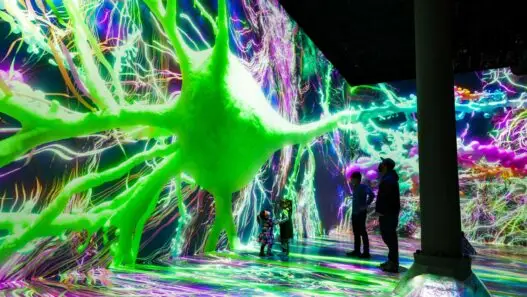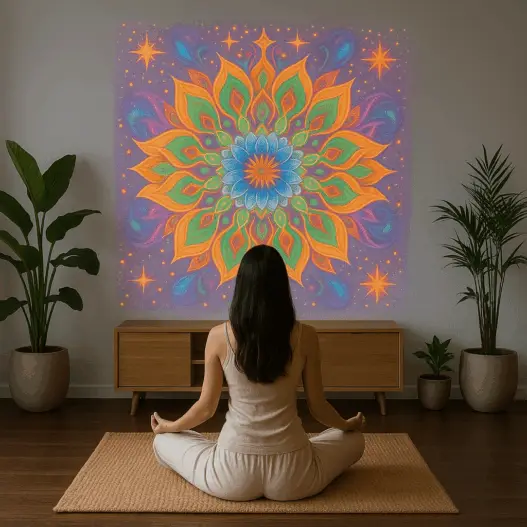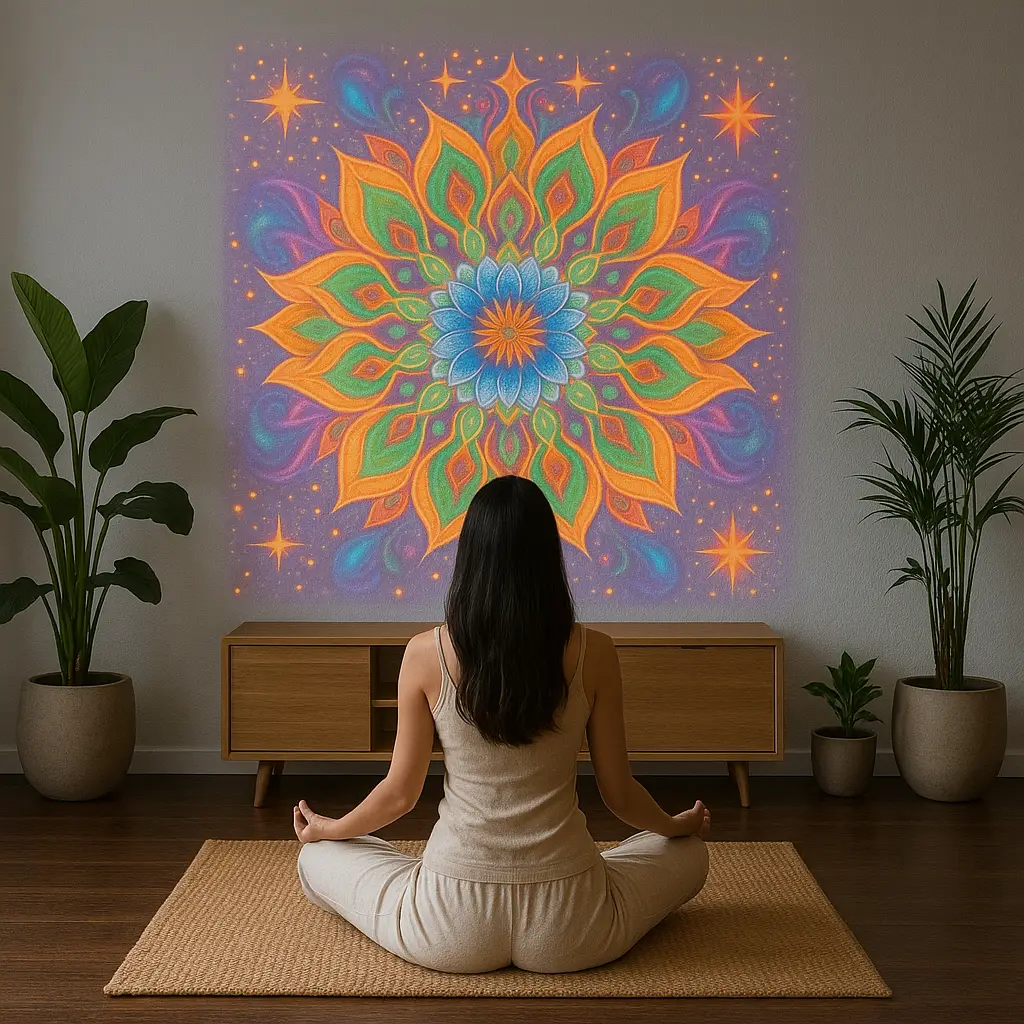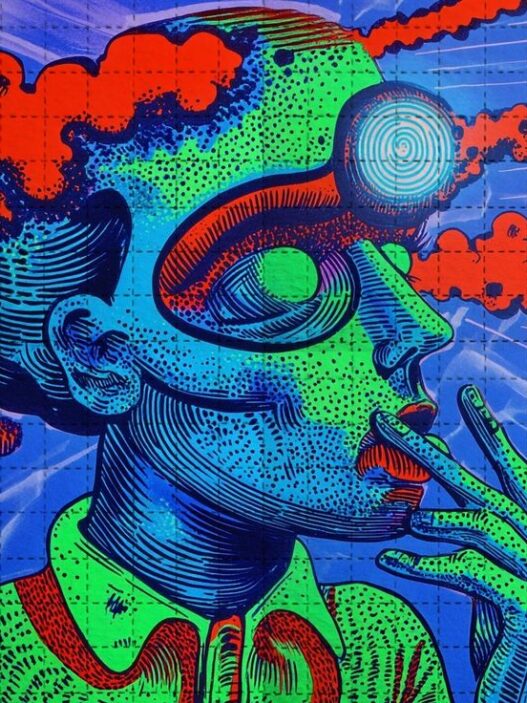In the vibrant heart of Eastern spiritual traditions lies an ancient tool that unites art, focus, and transformation: the mandala. Used for centuries in Buddhism and Hinduism, mandalas are more than just beautiful geometric patterns—they are maps of the cosmos, mirrors of the mind, and gateways to deeper states of consciousness.
Meditating with a mandala is not about watching a shape—it’s about entering an inner journey, moving from distraction to stillness, from chaos to clarity. Whether you’re seeking mindfulness, emotional healing, or a connection to the divine, the mandala meditation practice can be a powerful guide.
In this article, we’ll explore the origins, symbolism, scientific benefits, and step-by-step instructions on how to meditate using mandalas, along with key studies and traditional insights.
1. What Is a Mandala? A Sacred Circle of Consciousness
🔹 Etymology:
The word “mandala” comes from Sanskrit, meaning “circle” or “sacred center.”
🔹 Origins:
- Hinduism: Used in Vedic rituals and yantras to focus on deities
- Buddhism: Especially in Tibetan Vajrayana, mandalas represent deities, cosmic realms, and states of awareness
“A mandala is a psychological expression of the totality of the self.” — Carl Jung (Jung, 1959)
2. Why Mandalas Work in Meditation
🧠 A. Visual Focus and Mind Stillness
Mandalas engage the visual cortex and anchor the mind in form, color, and symmetry—reducing inner chatter.
🌀 B. Symbolic Journey Inward
Most mandalas are designed to be entered from the outer circle to the center, symbolizing a journey from the external world to inner truth.
💡 Scientific Benefits:
A 2010 study found that mandala coloring and viewing reduced anxiety and increased mindfulness, especially in beginners (Curry & Kasser, 2005).
Mandala meditation can:
- Lower cortisol (stress hormone)
- Improve focus and attention span
- Enhance emotional processing
3. Mandalas in Hinduism and Buddhism
🕉️ In Hinduism:
- Mandalas appear in yantras, sacred diagrams used in Tantra and Puja rituals
- Sri Yantra, a complex sacred geometry, represents Shakti (divine feminine) and the union of spirit and matter
🧘♂️ In Buddhism (Especially Tibetan Vajrayana):
- Mandalas are elaborate depictions of Buddhist cosmology, often including deities, palaces, and symbolic colors
- They are used in visualization meditations, especially during initiation (abhisheka)
- Famous example: Kalachakra Mandala, representing the Wheel of Time
4. The Psychological Dimension: Jung and the Mandala
Carl Jung introduced mandalas to Western psychology after encountering them during his self-exploration and studies of Eastern philosophy.
- He saw them as expressions of the “Self”—the union of the conscious and unconscious mind
- Drawing or meditating with mandalas, he claimed, helped bring inner harmony and individuation (Jung, 1959)
💡 Jung said: “I had to draw a mandala every morning, and this seemed to correspond to my inner situation at the time.”
5. How to Meditate with a Mandala: Step-by-Step
You don’t need to be a monk or artist to start. Just bring presence and an open heart.
✨ Step 1: Choose or Create Your Mandala
- Use a traditional Tibetan or Hindu mandala
- Or create your own mandala (freeform, colored, or guided templates)
- You can also use digital mandalas, projected or printed
🪷 Step 2: Prepare Your Space
- Sit in a comfortable position
- Light a candle or incense
- Play soft ambient or mantra music if desired
- Dim the lights to reduce distractions
🧘 Step 3: Set Your Intention
Silently ask:
- “What am I seeking to understand today?”
- “May I see clearly what lies within.”
Intention aligns your conscious attention with subconscious awareness.
👁️ Step 4: Gaze into the Mandala
- Soften your gaze
- Begin from the outer edge, slowly tracing the design inward
- Allow the center (bindu) to pull your awareness inward
- Let the mandala “breathe” with you—inhale into the center, exhale outward
Duration: Start with 10–15 minutes, gradually increasing to 30–45 minutes
6. What You Might Experience
Everyone’s experience with mandala meditation is unique, but common outcomes include:
✅ Deep sense of inner stillness
✅ Visual insights or spontaneous imagery
✅ Emotional release or healing
✅ A sense of unity, balance, or divine presence
Some practitioners report moments of non-dual awareness—the feeling that there is no separation between self and the mandala, or even between self and the universe.
“In the center of the mandala, I felt no thought—only presence. And in that stillness, I remembered I am whole.” — Student of Tibetan Dzogchen meditation, 2022
7. Advanced Practices: Mandala Visualization in Tibetan Buddhism
For those who want to go deeper, Tibetan Buddhist monks engage in deity visualization practices:
- Visualize entering the mandala palace
- See themselves as the deity at the center
- Chant mantras (e.g., Om Mani Padme Hum) while circulating through layers of symbolic space
- Dissolve the entire mandala in light—symbolizing impermanence and non-attachment
These practices are often taught in formal initiations and require guidance, but the underlying principle—visualizing inner wholeness—can benefit anyone.
8. The Mandala as a Mirror
Mandala meditation is not about seeing something outside of yourself. It’s about remembering what’s already within.
- The outer circle represents your environment
- The middle structure symbolizes the energies of the psyche
- The center point is your awareness, your soul, your true self
💡 Every time you meditate with a mandala, you’re centering your own consciousness—layer by layer, breath by breath.
Final Thought: A Path to Inner Harmony
In both Buddhist and Hindu traditions, mandalas are tools for awakening, healing, and returning to the center of the self. Modern science now echoes what monks and sages have known for centuries: when you focus deeply on meaningful symbols, your brain calms, your heart opens, and your soul begins to speak.
Meditating with mandalas may seem simple—but it leads to something profound: inner silence, clarity, and the experience of wholeness.
Are you ready to trace the path inward?
References:
- Jung, C.G. (1959). Mandala Symbolism. Princeton University Press.
- Carhart-Harris RL et al. (2012). Neural correlates of the psychedelic state. PubMed
- Curry, N. & Kasser, T. (2005). Can coloring mandalas reduce anxiety? Art Therapy Journal. PubMed
- Lebedev AV et al. (2015). Finding the self by losing the self. PubMed
- Kaertner L et al. (2021). Spiritual experiences and brain networks. PubMed





















